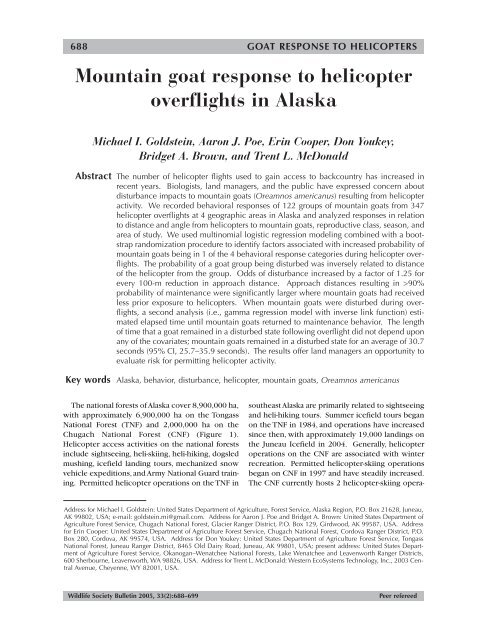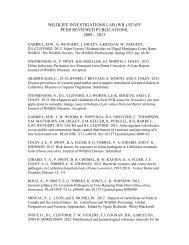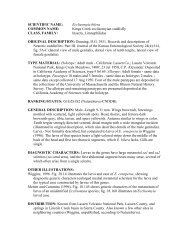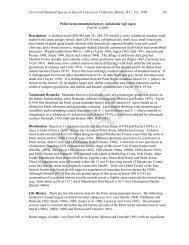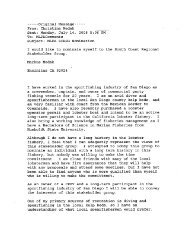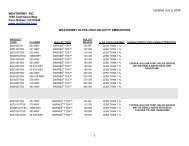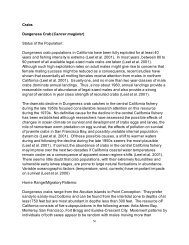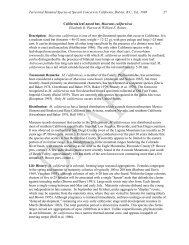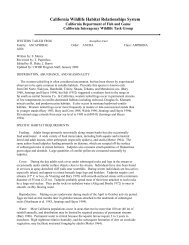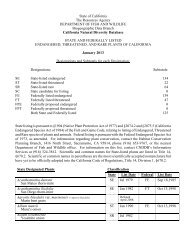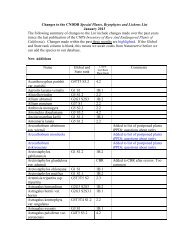Mountain Goat Response to Helicopter Overflights in Alaska (PDF)
Mountain Goat Response to Helicopter Overflights in Alaska (PDF)
Mountain Goat Response to Helicopter Overflights in Alaska (PDF)
Create successful ePaper yourself
Turn your PDF publications into a flip-book with our unique Google optimized e-Paper software.
688 GOAT RESPONSE TO HELICOPTERS<br />
<strong>Mounta<strong>in</strong></strong> goat response <strong>to</strong> helicopter<br />
overflights <strong>in</strong> <strong>Alaska</strong><br />
Michael I. Goldste<strong>in</strong>, Aaron J. Poe, Er<strong>in</strong> Cooper, Don Youkey,<br />
Bridget A. Brown, and Trent L. McDonald<br />
Abstract The number of helicopter flights used <strong>to</strong> ga<strong>in</strong> access <strong>to</strong> backcountry has <strong>in</strong>creased <strong>in</strong><br />
recent years. Biologists, land managers, and the public have expressed concern about<br />
disturbance impacts <strong>to</strong> mounta<strong>in</strong> goats (Oreamnos americanus) result<strong>in</strong>g from helicopter<br />
activity. We recorded behavioral responses of 122 groups of mounta<strong>in</strong> goats from 347<br />
helicopter overflights at 4 geographic areas <strong>in</strong> <strong>Alaska</strong> and analyzed responses <strong>in</strong> relation<br />
<strong>to</strong> distance and angle from helicopters <strong>to</strong> mounta<strong>in</strong> goats, reproductive class, season, and<br />
area of study. We used mult<strong>in</strong>omial logistic regression model<strong>in</strong>g comb<strong>in</strong>ed with a bootstrap<br />
randomization procedure <strong>to</strong> identify fac<strong>to</strong>rs associated with <strong>in</strong>creased probability of<br />
mounta<strong>in</strong> goats be<strong>in</strong>g <strong>in</strong> 1 of the 4 behavioral response categories dur<strong>in</strong>g helicopter overflights.<br />
The probability of a goat group be<strong>in</strong>g disturbed was <strong>in</strong>versely related <strong>to</strong> distance<br />
of the helicopter from the group. Odds of disturbance <strong>in</strong>creased by a fac<strong>to</strong>r of 1.25 for<br />
every 100-m reduction <strong>in</strong> approach distance. Approach distances result<strong>in</strong>g <strong>in</strong> >90%<br />
probability of ma<strong>in</strong>tenance were significantly larger where mounta<strong>in</strong> goats had received<br />
less prior exposure <strong>to</strong> helicopters. When mounta<strong>in</strong> goats were disturbed dur<strong>in</strong>g overflights,<br />
a second analysis (i.e., gamma regression model with <strong>in</strong>verse l<strong>in</strong>k function) estimated<br />
elapsed time until mounta<strong>in</strong> goats returned <strong>to</strong> ma<strong>in</strong>tenance behavior. The length<br />
of time that a goat rema<strong>in</strong>ed <strong>in</strong> a disturbed state follow<strong>in</strong>g overflight did not depend upon<br />
any of the covariates; mounta<strong>in</strong> goats rema<strong>in</strong>ed <strong>in</strong> a disturbed state for an average of 30.7<br />
seconds (95% CI, 25.7–35.9 seconds). The results offer land managers an opportunity <strong>to</strong><br />
evaluate risk for permitt<strong>in</strong>g helicopter activity.<br />
Key words <strong>Alaska</strong>, behavior, disturbance, helicopter, mounta<strong>in</strong> goats, Oreamnos americanus<br />
The national forests of <strong>Alaska</strong> cover 8,900,000 ha,<br />
with approximately 6,900,000 ha on the Tongass<br />
National Forest (TNF) and 2,000,000 ha on the<br />
Chugach National Forest (CNF) (Figure 1).<br />
<strong>Helicopter</strong> access activities on the national forests<br />
<strong>in</strong>clude sightsee<strong>in</strong>g, heli-ski<strong>in</strong>g, heli-hik<strong>in</strong>g, dogsled<br />
mush<strong>in</strong>g, icefield land<strong>in</strong>g <strong>to</strong>urs, mechanized snow<br />
vehicle expeditions, and Army National Guard tra<strong>in</strong><strong>in</strong>g.<br />
Permitted helicopter operations on the TNF <strong>in</strong><br />
southeast <strong>Alaska</strong> are primarily related <strong>to</strong> sightsee<strong>in</strong>g<br />
and heli-hik<strong>in</strong>g <strong>to</strong>urs. Summer icefield <strong>to</strong>urs began<br />
on the TNF <strong>in</strong> 1984, and operations have <strong>in</strong>creased<br />
s<strong>in</strong>ce then, with approximately 19,000 land<strong>in</strong>gs on<br />
the Juneau Icefield <strong>in</strong> 2004. Generally, helicopter<br />
operations on the CNF are associated with w<strong>in</strong>ter<br />
recreation. Permitted helicopter-ski<strong>in</strong>g operations<br />
began on CNF <strong>in</strong> 1997 and have steadily <strong>in</strong>creased.<br />
The CNF currently hosts 2 helicopter-ski<strong>in</strong>g opera-<br />
Address for Michael I. Goldste<strong>in</strong>: United States Department of Agriculture, Forest Service, <strong>Alaska</strong> Region, P.O. Box 21628, Juneau,<br />
AK 99802, USA; e-mail: goldste<strong>in</strong>.mi@gmail.com. Address for Aaron J. Poe and Bridget A. Brown: United States Department of<br />
Agriculture Forest Service, Chugach National Forest, Glacier Ranger District, P.O. Box 129, Girdwood, AK 99587, USA. Address<br />
for Er<strong>in</strong> Cooper: United States Department of Agriculture Forest Service, Chugach National Forest, Cordova Ranger District, P.O.<br />
Box 280, Cordova, AK 99574, USA. Address for Don Youkey: United States Department of Agriculture Forest Service, Tongass<br />
National Forest, Juneau Ranger District, 8465 Old Dairy Road, Juneau, AK 99801, USA; present address: United States Department<br />
of Agriculture Forest Service, Okanogan–Wenatchee National Forests, Lake Wenatchee and Leavenworth Ranger Districts,<br />
600 Sherbourne, Leavenworth, WA 98826, USA. Address for Trent L. McDonald: Western EcoSystems Technology, Inc., 2003 Central<br />
Avenue, Cheyenne, WY 82001, USA.<br />
Wildlife Society Bullet<strong>in</strong> 2005, 33(2):688–699 Peer refereed
Figure 1. The locations of mounta<strong>in</strong> goat disturbance study areas <strong>in</strong> <strong>Alaska</strong>, 2001–2002.<br />
tions, which reported a <strong>to</strong>tal of 1,952 land<strong>in</strong>gs <strong>in</strong><br />
w<strong>in</strong>ter of 2004. As helicopter activity <strong>in</strong>creases <strong>in</strong><br />
the backcountry, the potential for impacts <strong>to</strong><br />
wildlife populations may <strong>in</strong>crease.<br />
The degree <strong>to</strong> which overflights <strong>in</strong>fluence<br />
wildlife depends on characteristics of the aircraft<br />
and flight activities, as well as species or <strong>in</strong>dividual<br />
specific fac<strong>to</strong>rs <strong>in</strong>clud<strong>in</strong>g life his<strong>to</strong>ry, habitat associations,<br />
season, sex, age, and prior experience with<br />
aircraft (National Park Service 1994; Maier 1996).<br />
The relationships between overflights and impacts<br />
<strong>to</strong> wildlife are complex, but generally, the closer the<br />
disturbance stimulus, the more likely an animal will<br />
be disturbed (Berger et al. 1983, Krausman and<br />
Hervert 1983,Knight and Knight 1984,S<strong>to</strong>ckwell et<br />
al. 1991). Additionally, helicopter overflights are<br />
thought <strong>to</strong> elicit greater responses than fixed-w<strong>in</strong>g<br />
overflights (Bleich et al. 1994, National Park Service<br />
1994, Born et al. 1999,Ward et al. 1999, Frid 2003).<br />
<strong>Mounta<strong>in</strong></strong> goat (Oreamnos americanus) view<strong>in</strong>g<br />
is an important recreational wildlife activity <strong>in</strong> the<br />
state of <strong>Alaska</strong>. <strong>Mounta<strong>in</strong></strong> goats also are an impor-<br />
<strong>Goat</strong> response <strong>to</strong> helicopters Goldste<strong>in</strong> et al. 689<br />
tant game species. S<strong>in</strong>ce 1992 approximately 3,000<br />
goats were harvested <strong>in</strong> south-central and southeast<br />
<strong>Alaska</strong>. <strong>Mounta<strong>in</strong></strong> goats exhibit a variety of responses<br />
<strong>to</strong> aircraft, many of which duplicate their<br />
response <strong>to</strong> preda<strong>to</strong>rs, such as rapid retreat <strong>to</strong><br />
escape cover, which could disrupt forag<strong>in</strong>g and<br />
care of young and may result <strong>in</strong> <strong>in</strong>jury or death<br />
(Berger et al. 1983, Chadwick 1983, Côté 1996,<br />
Sutherland 1996).<br />
<strong>Mounta<strong>in</strong></strong> goats may be susceptible <strong>to</strong> disturbance<br />
result<strong>in</strong>g from helicopter overflights (Foster<br />
and Rahs 1983, Côté 1996). Immediate responses<br />
of mounta<strong>in</strong> goats <strong>to</strong> helicopter disturbance likely<br />
are <strong>in</strong>fluenced by sex, age, season, prior experience,<br />
habitat, and characteristics of the helicopter<br />
activity (e.g., sl<strong>in</strong>g loads, flight-see<strong>in</strong>g, land<strong>in</strong>gs for<br />
passenger pickup and dropoff), and are therefore<br />
multifaceted and difficult <strong>to</strong> predict. This complexity<br />
has contributed <strong>to</strong> <strong>in</strong>consistencies between recommended<br />
mitigations and regulations <strong>in</strong>tended <strong>to</strong><br />
m<strong>in</strong>imize disturbance impacts.<br />
We characterized disturbance behavior <strong>in</strong>
690 Wildlife Society Bullet<strong>in</strong> 2005, 33(2):688–699<br />
response <strong>to</strong> commercial and experimental helicopter<br />
overflights similar <strong>to</strong> recreational flight-see<strong>in</strong>g<br />
and commuter activities on national forests <strong>in</strong><br />
<strong>Alaska</strong>. We then evaluated the importance of variables<br />
that affected the behavioral response by<br />
mounta<strong>in</strong> goats. This study represented a unique<br />
opportunity <strong>to</strong> study differences between areas<br />
with differ<strong>in</strong>g levels of helicopter activity and possibly<br />
mounta<strong>in</strong> goat habituation. We quantified the<br />
behavioral responses of mounta<strong>in</strong> goats under regular<br />
susta<strong>in</strong>ed helicopter activity and compared<br />
those <strong>to</strong> the responses of mounta<strong>in</strong> goats unaccus<strong>to</strong>med<br />
<strong>to</strong> helicopter activity. Our goal was <strong>to</strong> predict<br />
the levels of disturbance helicopter operations<br />
would have on mounta<strong>in</strong>s goats on national forest<br />
lands and <strong>to</strong> provide managers with a way <strong>to</strong> measure<br />
risk of disturbance when consider<strong>in</strong>g permitspecific<br />
conditions for helicopter traffic.<br />
Study area<br />
We sampled goat behavior at 4 study areas <strong>in</strong><br />
south-central and southeast <strong>Alaska</strong> <strong>in</strong> 2001 and 2002<br />
(Figure 1). Study areas were similar <strong>in</strong> <strong>to</strong>pography,<br />
physical condition, and vegetation. Sites were located<br />
on rough, rocky, steep terra<strong>in</strong> conta<strong>in</strong><strong>in</strong>g glaciers<br />
and permanent snowfields, yet under a maritime climate<br />
with high precipitation. Vegetation cover consisted<br />
of alp<strong>in</strong>e shrubs,grasses,and forbs. Groups of<br />
mounta<strong>in</strong> goats occurred <strong>in</strong> discrete areas separated<br />
by <strong>in</strong>tersect<strong>in</strong>g glacial valleys. The discrete distribution<br />
of groups of mounta<strong>in</strong> goats allowed for experimental<br />
evaluation of disturbance response, as <strong>in</strong>dividuals<br />
occurr<strong>in</strong>g at sampled locations had limited<br />
opportunity <strong>to</strong> migrate <strong>in</strong><strong>to</strong> or out of other sample<br />
areas dur<strong>in</strong>g the relatively short sampl<strong>in</strong>g periods.<br />
Potential preda<strong>to</strong>rs of goats with<strong>in</strong> study areas<br />
<strong>in</strong>cluded: wolves (Canis lupus), wolver<strong>in</strong>es (Gulo<br />
gulo), lynx (Lynx lynx), black bears (Ursus americanus),<br />
brown bears (Ursus arc<strong>to</strong>s), golden eagles<br />
(Aquila chrysae<strong>to</strong>s), and bald eagles (Haliaeetus<br />
leucocephalus).<br />
We sampled mounta<strong>in</strong> goats <strong>in</strong> w<strong>in</strong>ter, spr<strong>in</strong>g,<br />
and summer.We sampled the Kenai Pen<strong>in</strong>sula–Turnaga<strong>in</strong><br />
Arm study area (KP) dur<strong>in</strong>g w<strong>in</strong>ter (i.e., late<br />
March–April), the Eastern Pr<strong>in</strong>ce William Sound<br />
study area (EPWS) dur<strong>in</strong>g spr<strong>in</strong>g (i.e., late<br />
May–early June), the Chilkat <strong>Mounta<strong>in</strong></strong> Range study<br />
area (CKT) <strong>in</strong> summer (i.e.,August), and the Juneau<br />
Icefield study area (ICE) dur<strong>in</strong>g spr<strong>in</strong>g (i.e., June)<br />
and summer (i.e., July). Sampl<strong>in</strong>g areas dur<strong>in</strong>g different<br />
seasons were based on 1) climatic con-<br />
stra<strong>in</strong>ts, 2) a priori determ<strong>in</strong>ation of which sites<br />
could receive future human activity dur<strong>in</strong>g a particular<br />
season, and 3) logistical constra<strong>in</strong>ts of personnel<br />
and aircraft availability.<br />
We sought <strong>to</strong> assess whether behavioral responses<br />
by mounta<strong>in</strong> goats accus<strong>to</strong>med <strong>to</strong> chronic overflight<br />
activity were different from those of goats at<br />
sites with less helicopter activity, and used this criterion<br />
<strong>to</strong> select sampl<strong>in</strong>g areas. Based on permitted<br />
helicopter activity and known flight corridors,<br />
mounta<strong>in</strong> goats were presumed <strong>to</strong> have prior exposure<br />
<strong>to</strong> helicopter ranked from least <strong>to</strong> greatest:<br />
EPWS, KP, CKT, and ICE. Fixed-w<strong>in</strong>g aircraft activity<br />
occurred <strong>in</strong> all areas. Hunt<strong>in</strong>g was permitted <strong>in</strong><br />
all areas except most sites sampled at ICE.<br />
Data collection<br />
We used exist<strong>in</strong>g mounta<strong>in</strong> goat survey and sight<strong>in</strong>g<br />
records <strong>to</strong> identify locations where groundbased<br />
observers would be able <strong>to</strong> evaluate mounta<strong>in</strong><br />
goat responses <strong>to</strong> helicopter overflights. We<br />
positioned 2 observers approximately 1.6 km away<br />
from the group of mounta<strong>in</strong> goats. This distance<br />
was far enough away <strong>to</strong> not cause noticeable<br />
responses by mounta<strong>in</strong> goats <strong>to</strong> humans on the<br />
ground, but close enough <strong>to</strong> record behaviors. One<br />
person used a 15–60X spott<strong>in</strong>g scope <strong>to</strong> observe<br />
behaviors while the second person recorded data.<br />
We targeted a 25X video camera on the most complete<br />
view of the group of mounta<strong>in</strong> goats. We synchronized<br />
time with the behavioral sampl<strong>in</strong>g,<br />
which was displayed on the video screen and<br />
recorded. This time-stamped footage provided a<br />
cont<strong>in</strong>uous audiovisual log that was available for<br />
verification of behavior data.<br />
We sampled groups of 1–17 <strong>in</strong>dividuals, but<br />
simultaneous behavioral data were collected on<br />
only 9 <strong>in</strong>dividuals, selected by random number<br />
table. We def<strong>in</strong>ed 8 categories of behavior: flee<strong>in</strong>g;<br />
defense–hide; alert (i.e., agitated or head tilted <strong>in</strong><br />
direction of the stimulus); forag<strong>in</strong>g (<strong>in</strong>clud<strong>in</strong>g small<br />
bouts of locomotion from one feed<strong>in</strong>g site <strong>to</strong> another);<br />
nurs<strong>in</strong>g; walk<strong>in</strong>g; stand<strong>in</strong>g; and ly<strong>in</strong>g. When we<br />
could not observe animals, we recorded them as<br />
out-of-sight. We collected scan samples on each animal<br />
at 1-m<strong>in</strong>ute <strong>in</strong>tervals for 15 m<strong>in</strong>utes prior <strong>to</strong><br />
and 15 m<strong>in</strong>ute follow<strong>in</strong>g a 3-m<strong>in</strong>ute <strong>in</strong>tercept period<br />
(as def<strong>in</strong>ed below). We <strong>to</strong>ok scan samples once<br />
every 10 seconds when helicopters were approximately<br />
3 km (or 1 m<strong>in</strong>ute, at a speed of 100 knots)<br />
away from groups of mounta<strong>in</strong> goats until 2 m<strong>in</strong>utes<br />
after the helicopter passed over each group.
This resulted <strong>in</strong> a m<strong>in</strong>imum of 33 m<strong>in</strong>utes of data<br />
collection for each flight. We recorded sex and age<br />
of mounta<strong>in</strong> goats.<br />
Experimental overflights<br />
<strong>Helicopter</strong>s flew past groups of mounta<strong>in</strong> goats<br />
at a constant speed (~51 m/sec) and direction at<br />
distances between 143 m and 1,911 m. At KP,<br />
EPWS, and CKT we contracted experimental overflights<br />
of A-Star AS-350 helicopters (American<br />
Eurocopter, Grand Prairie, Tex.) <strong>to</strong> fly over groups<br />
of mounta<strong>in</strong> goats at distances between 250 m and<br />
2,000 m as directed by ground observers. At ICE,A-<br />
Star helicopters operated regular flight l<strong>in</strong>es dur<strong>in</strong>g<br />
sightsee<strong>in</strong>g <strong>to</strong>urs under federal special-use permits.<br />
Commercial opera<strong>to</strong>rs were not permitted <strong>to</strong> fly<br />
692 Wildlife Society Bullet<strong>in</strong> 2005, 33(2):688–699<br />
sis estimated elapsed time until goats returned <strong>to</strong><br />
ma<strong>in</strong>tenance behavior.<br />
In the first analysis, we fit a mult<strong>in</strong>omial logistic<br />
regression model (Hosmer and Lemeshow 2000) <strong>to</strong><br />
the data. We used the mult<strong>in</strong>omial regression analysis<br />
<strong>to</strong> identify a model conta<strong>in</strong><strong>in</strong>g study variables<br />
that best described variation <strong>in</strong> the probability of<br />
groups of mounta<strong>in</strong> goats be<strong>in</strong>g <strong>in</strong> each of the 4<br />
behavioral categories. The mult<strong>in</strong>omial regression<br />
model was a generalization of b<strong>in</strong>omial logistic<br />
regression (Hosmer and Lemeshow 2000) and related<br />
the logarithm of probability ratios for 3 types of<br />
behavior <strong>to</strong> measured study covariates. The 3 mult<strong>in</strong>omial<br />
regression equations <strong>in</strong>volved the probability<br />
of a goat group be<strong>in</strong>g alert dur<strong>in</strong>g the overflight<br />
(π a ), the probability of a goat group be<strong>in</strong>g vigilant<br />
dur<strong>in</strong>g the overflight (π v ), the probability of a goat<br />
group flee<strong>in</strong>g dur<strong>in</strong>g the overflight (π f ), and the<br />
probability of a goat group display<strong>in</strong>g ma<strong>in</strong>tenance<br />
behavior dur<strong>in</strong>g the overflight (π m ). For convenience,<br />
we chose <strong>to</strong> use π m as the reference category<br />
<strong>in</strong> the denom<strong>in</strong>a<strong>to</strong>r of the ratios, given that we<br />
would have obta<strong>in</strong>ed the same model and results<br />
had we chosen a different reference category.<br />
Because of the 4 response categories, 3(p +1) <strong>to</strong>tal<br />
coefficients were estimated <strong>in</strong> the model,1 for each<br />
covariate and equation, when p explana<strong>to</strong>ry variables<br />
were <strong>in</strong>cluded <strong>in</strong> the model.<br />
We estimated coefficients (i.e.,β) of the model by<br />
maximiz<strong>in</strong>g the 4 category conditional mult<strong>in</strong>omial<br />
likelihood of the data (Mood et al. 1974). Assum<strong>in</strong>g<br />
the observed disturbance responses are coded<br />
(Table 1),the likelihood of the data is conditional on<br />
the covariates (Hosmer and Lemeshow 2000). This<br />
likelihood was maximized iteratively <strong>to</strong> obta<strong>in</strong> estimates<br />
of the β coefficients us<strong>in</strong>g S-Plus (Venables<br />
and Ripley 1999). We discarded standard errors of<br />
the coefficients because they were potentially<br />
biased by dependencies <strong>in</strong> the data. We established<br />
confidence <strong>in</strong>tervals for the coefficients us<strong>in</strong>g the<br />
bootstrap method described below. Once coeffi-<br />
Table 1. Behavioral responses of groups of mounta<strong>in</strong> goats <strong>to</strong> helicopter overflights at 4 study<br />
areas <strong>in</strong> <strong>Alaska</strong> dur<strong>in</strong>g 2001 and 2002.<br />
Ma<strong>in</strong>tenance Alert Vigilant Flee<strong>in</strong>g<br />
Site n % n % n % n % Total<br />
Chilkat <strong>Mounta<strong>in</strong></strong>s 48 61.5 10 12.8 19 24.4 1 1.3 78<br />
E. Pr<strong>in</strong>ce William Sound 29 50.0 7 12.1 17 29.3 5 8.6 58<br />
Kenai Pen<strong>in</strong>sula 58 63.0 7 7.6 10 10.9 17 18.5 92<br />
Juneau Icefield 92 77.3 11 9.2 7 5.9 9 7.6 119<br />
Total 227 65.4 35 10.1 53 15.3 32 9.2 347<br />
cients were estimated, we calculated predicted values<br />
for the probabilities of each disturbance class as,<br />
such that πˆ a + πˆ v + πˆ f + πˆ m = 1 for every unique<br />
set of covariate values.<br />
The covariates of <strong>in</strong>terest <strong>in</strong> the mult<strong>in</strong>omial<br />
regression analysis were study area, reproductive<br />
class of the group of mounta<strong>in</strong> goats, closest<br />
approach of the helicopter <strong>to</strong> the group of mounta<strong>in</strong><br />
goats, angle of the helicopter <strong>to</strong> the group of mounta<strong>in</strong><br />
goats, and season. We treated study area, reproductive<br />
class, and season as discrete fac<strong>to</strong>rs conta<strong>in</strong>-<br />
<strong>in</strong>g 4, 3, and 3 levels,<br />
respectively. Distance and<br />
angle were cont<strong>in</strong>uous<br />
covariates. Pairwise <strong>in</strong>teractions<br />
among these<br />
covariates also were of<br />
<strong>in</strong>terest.<br />
We used Schwarz’s<br />
Bayesian Criterion (SBC)<br />
(Schwarz 1978) <strong>to</strong> select<br />
a set of covariates that
est expla<strong>in</strong>ed variation <strong>in</strong> the probabilities of<br />
each response, by fitt<strong>in</strong>g and assess<strong>in</strong>g all possible<br />
models conta<strong>in</strong><strong>in</strong>g the covariates of <strong>in</strong>terest and<br />
their <strong>in</strong>teractions.<br />
We considered models with SBC close (< ~6.0) <strong>to</strong><br />
the m<strong>in</strong>imum SBC, obta<strong>in</strong>ed over all possible models,<br />
reasonable models and identical <strong>in</strong> fit as measured<br />
by SBC. We selected the f<strong>in</strong>al reported mult<strong>in</strong>omial<br />
model from among this set of models with SBC<br />
close <strong>to</strong> the m<strong>in</strong>imum. With 5 covariates and all pairwise<br />
<strong>in</strong>teractions of <strong>in</strong>terest, 1,449 models were possible.<br />
Once a f<strong>in</strong>al mult<strong>in</strong>omial model was selected,<br />
confidence <strong>in</strong>tervals for coefficients <strong>in</strong> the model<br />
were computed us<strong>in</strong>g a bootstrap method (Manly<br />
1997) that accounted for the fact that multiple<br />
flights over a s<strong>in</strong>gle group occurred on the same day<br />
at vary<strong>in</strong>g distances and angles. We assumed the<br />
<strong>in</strong>fluence of this type of dependency <strong>to</strong> be small<br />
because most groups (n = 76 of 122,62.3%) received<br />
1 or 2 overflights on the same day,41 groups (33.6%)<br />
received between 3 and 7 overflights on the same<br />
day, and 5 groups (4.1%) received >7 overflights on<br />
the same day. Nonetheless, the bootstrap method<br />
accounted for potential dependencies among<br />
responses from the same group by resampl<strong>in</strong>g, with<br />
replacement,mounta<strong>in</strong> goat group identifiers (Manly<br />
1997). The process of resampl<strong>in</strong>g the orig<strong>in</strong>al data<br />
and refitt<strong>in</strong>g coefficients was repeated 1,000 times,<br />
and variation <strong>in</strong> the refitted coefficients over these<br />
<strong>Goat</strong> response <strong>to</strong> helicopters Goldste<strong>in</strong> et al. 693<br />
Figure 2. The observed distribution of disturbance time for <strong>in</strong>dividual mounta<strong>in</strong> goats that<br />
entered one of the positive disturbance categories (vigilant, alert, or flee<strong>in</strong>g). Observations<br />
pooled from all areas, distances, angles, and seasons (n = 194) <strong>in</strong> <strong>Alaska</strong>, 2001–2002.<br />
1,000 iterations correctly<br />
represented variation of<br />
the orig<strong>in</strong>al coefficients <strong>in</strong><br />
the presence of whatever<br />
dependencies existed <strong>in</strong><br />
the orig<strong>in</strong>al data set. To<br />
quantify that variation, we<br />
constructed 95% confidence<br />
<strong>in</strong>tervals for each<br />
coefficient by comput<strong>in</strong>g<br />
the 2.5th and 97.5th percentile<br />
of the 1,000 bootstrapped<br />
values for each<br />
coefficient. We considered<br />
a coefficient significantly<br />
different from 0 at the α =<br />
0.05 level if its 95% confidence<br />
<strong>in</strong>terval did not conta<strong>in</strong><br />
0.<br />
In the second analysis,<br />
we classified <strong>in</strong>dividual<br />
mounta<strong>in</strong> goats as disturbed<br />
(i.e., alert, vigilant,<br />
flee<strong>in</strong>g) or not disturbed (i.e., ma<strong>in</strong>tenance) dur<strong>in</strong>g<br />
their encounter with the helicopter. From observations<br />
of disturbed mounta<strong>in</strong> goats, the <strong>to</strong>tal amount<br />
of time spent <strong>in</strong> a disturbed state prior <strong>to</strong> return<strong>in</strong>g<br />
<strong>to</strong> the ma<strong>in</strong>tenance category was calculated. The<br />
amount of time a mounta<strong>in</strong> goat spent <strong>in</strong> a disturbed<br />
state formed the response variable <strong>in</strong> a<br />
regression analysis that sought <strong>to</strong> identify fac<strong>to</strong>rs<br />
associated with elongated states of disturbance and<br />
estimate average disturbance time. The overall distribution<br />
of disturbance time (Figure 2) was highly<br />
skewed <strong>to</strong>ward small values and could not be transformed<br />
such that it followed an approximate normal<br />
distribution. Because disturbance time followed<br />
an approximate gamma distribution (Mood<br />
et al.1974),a gamma regression model with <strong>in</strong>verse<br />
l<strong>in</strong>k function (McCullagh and Nelder 1989) was fit<br />
that related disturbance time <strong>to</strong> a function of the<br />
study covariates area, reproductive class, distance,<br />
and angle. Due <strong>to</strong> the reduced number of disturbed<br />
animals <strong>in</strong> the comb<strong>in</strong>ations of season and the<br />
other variables, season could not be considered <strong>in</strong><br />
the gamma regression model. As <strong>in</strong> the first analysis,<br />
we considered study area and reproductive<br />
class discrete <strong>in</strong>dica<strong>to</strong>r variables, while we considered<br />
the angle and distance variables as cont<strong>in</strong>uous<br />
variables.<br />
We selected the f<strong>in</strong>al gamma regression model<br />
the same way that the f<strong>in</strong>al mult<strong>in</strong>omial model was
694 Wildlife Society Bullet<strong>in</strong> 2005, 33(2):688–699<br />
Table 2. Estimated coefficients from the <strong>to</strong>p 4 mult<strong>in</strong>omial models for helicopter overflight disturbance<br />
of mounta<strong>in</strong>s goats <strong>in</strong> <strong>Alaska</strong> dur<strong>in</strong>g 2001 and 2002, as selected by Schwarz’s Bayesian<br />
Criterion. Model 3 was selected for use as the f<strong>in</strong>al model <strong>to</strong> discuss habituation of mounta<strong>in</strong><br />
goats <strong>to</strong> helicopters.<br />
Schwarz’s<br />
Coefficients <strong>in</strong> the logistic model<br />
Model no. Bayesian Criterion Variable πa /πm πv /πm πf /πm 1 714.6 (Intercept) –0.69552 –0.33478 –0.92113<br />
Distance –0.00188 –0.00178 –0.00163<br />
2 714.7 (Intercept) –1.23242 –0.83683 –0.93034<br />
Distance –0.00175 –0.00165 –0.00161<br />
Angle 0.01504 0.01420 –0.00009<br />
3 717.1 (Intercept) –0.97574 –1.38393 –0.92658<br />
Area.ckt a 0.42623 1.51822 –1.68300<br />
Area.epws a 1.02806 2.38028 0.96755<br />
Area.kp a 0.44507 1.27052 1.62840<br />
Distance –0.00204 –0.00213 –0.00258<br />
4 718.2 (Intercept) –2.36855 –1.91885 –1.98490<br />
Angle 0.01673 0.01587 0.00129<br />
a Indica<strong>to</strong>r variables for Area. Area.ckt = 1 if overflight was conducted <strong>in</strong> the Chilkat Range<br />
study area, 0 otherwise. Area.epws = 1 if overflight was conducted <strong>in</strong> Eastern Pr<strong>in</strong>ce William<br />
Sound study area, 0 otherwise. Area.kp = 1 if overflight was conducted <strong>in</strong> the Kenai Pen<strong>in</strong>sula<br />
study area, 0 otherwise.<br />
selected. All possible models conta<strong>in</strong><strong>in</strong>g the covariates<br />
of <strong>in</strong>terest and their <strong>in</strong>teractions were fit and<br />
assessed us<strong>in</strong>g SBC. Because we considered only 4<br />
covariates for <strong>in</strong>clusion <strong>in</strong> the gamma model, there<br />
were 113 possible models <strong>to</strong> consider. We could<br />
not ignore correlation <strong>in</strong>duced by observ<strong>in</strong>g multiple<br />
overflights for some <strong>in</strong>dividuals. Because multiple<br />
overflights of the same <strong>in</strong>dividual occurred at<br />
random and were not related <strong>to</strong> other fac<strong>to</strong>rs, the<br />
magnitude of coefficients <strong>in</strong> the gamma model was<br />
not biased, but standard errors of those coefficients<br />
were potentially <strong>to</strong>o small. As with the mult<strong>in</strong>omial<br />
model, we computed 95% confidence <strong>in</strong>tervals<br />
for coefficients <strong>in</strong> the f<strong>in</strong>al gamma model us<strong>in</strong>g the<br />
same bootstrap procedure outl<strong>in</strong>ed for the mult<strong>in</strong>omial<br />
model.<br />
Table 3. Confidence <strong>in</strong>tervals (95%) for coefficients <strong>in</strong> the f<strong>in</strong>al mult<strong>in</strong>omial model for helicopter<br />
disturbance of mounta<strong>in</strong>s goats <strong>in</strong> <strong>Alaska</strong> dur<strong>in</strong>g 2001 and 2002, computed by the bootstrap<br />
method. Confidence <strong>in</strong>tervals that do not conta<strong>in</strong> 0 <strong>in</strong>dicate a coefficient that was considered<br />
significantly different from 0 at the α = 0.05 level. These <strong>in</strong>tervals are denoted by “*”.<br />
Model for π a /π m Model for π v /π m Model for π f /π m<br />
Low limit Upper limit Low limit Upper limit Low limit Upper limit<br />
(Intercept) –2.19266 0.53531 –2.39442 –0.27322* –1.99062 0.19378<br />
Area.ckt –1.04700 2.04614 –0.28466 3.25171 –13.39977 0.48113<br />
Area.epws –0.62271 2.39648 1.16612 3.72196* –0.95883 2.41139<br />
Area.kp –0.94182 1.79736 0.05901 2.55882* 0.44596 3.04200*<br />
Distance –0.00471 –0.00058* –0.00381 –0.00130* –0.00527 –0.00110*<br />
Results<br />
We analyzed mounta<strong>in</strong><br />
goat response data for<br />
347 helicopter overflights<br />
on 122 groups <strong>in</strong> 4<br />
study areas dur<strong>in</strong>g 2001<br />
and 2002. Overall, we<br />
observed ma<strong>in</strong>tenance<br />
behaviors <strong>in</strong> 65.4% (n =<br />
227) of the flights and<br />
observed disturbance dur<strong>in</strong>g<br />
34.6% (n = 120) of the<br />
overflights (Table 1).<br />
Groups that we coded for<br />
disturbance collectively<br />
<strong>in</strong>cluded 773 <strong>in</strong>dividual<br />
mounta<strong>in</strong> goats. In those<br />
groups, 194 mounta<strong>in</strong><br />
goats (25.1%) had overt<br />
behavioral changes due <strong>to</strong><br />
helicopters; 66% of those<br />
mounta<strong>in</strong> goats were alert<br />
or vigilant and 34% fled.<br />
Model selection<br />
Among the 1,449 models fit dur<strong>in</strong>g model selection,<br />
4 had SBC values close <strong>to</strong> the m<strong>in</strong>imum (Table<br />
2). None of the <strong>to</strong>p 4 models conta<strong>in</strong>ed the variables<br />
reproductive class or season,nor did they conta<strong>in</strong> any<br />
<strong>in</strong>teractions. Distance appeared <strong>in</strong> 3 of the 4 models,<br />
angle appeared <strong>in</strong> 2 of the 4,and study area appeared<br />
<strong>in</strong> 1 of the 4 models. We chose <strong>to</strong> discuss model 3 as<br />
the f<strong>in</strong>al mult<strong>in</strong>omial model because we have a<br />
unique opportunity <strong>to</strong> assess the question of habituation<br />
<strong>in</strong> an explora<strong>to</strong>ry fashion. Model 3 conta<strong>in</strong>ed<br />
the variables distance and study area. If mounta<strong>in</strong><br />
goats can become habituated <strong>to</strong> helicopter flights,<br />
then management of overflights may be implemented<br />
regionally or locally.<br />
Nonetheless, all 4 models<br />
have essentially the same<br />
amount of support,accord<strong>in</strong>g<br />
<strong>to</strong> SBC. Bootstrap confidence<br />
<strong>in</strong>tervals for coefficients<br />
<strong>in</strong> model 3 appear <strong>in</strong><br />
Table 3.<br />
Results of model 3 <strong>in</strong>dicated<br />
that the probability<br />
of a goat group be<strong>in</strong>g <strong>in</strong><br />
one of the disturbed classes<br />
(alert, vigilant, or flee-
Figure 3a. Probabilities of each disturbance category (e.g., x, y,<br />
z) as a function of distance from the mounta<strong>in</strong> goats <strong>in</strong> the Eastern<br />
Pr<strong>in</strong>ce William Sound study area, <strong>Alaska</strong>, 2001–2002, as<br />
predicted by the f<strong>in</strong>al mult<strong>in</strong>omial regression model. The probability<br />
of mounta<strong>in</strong> goats be<strong>in</strong>g <strong>in</strong> the ma<strong>in</strong>tenance category is<br />
>90% if aircraft approach is >1,730 m.<br />
Figure 3c. Probabilities of each disturbance category (e.g., x, y,<br />
z) as a function of distance from the mounta<strong>in</strong> goats <strong>in</strong> the<br />
Chilkat Range study area, <strong>Alaska</strong>, 2001–2002, as predicted by<br />
the f<strong>in</strong>al mult<strong>in</strong>omial regression model. The probability of<br />
mounta<strong>in</strong> goats be<strong>in</strong>g <strong>in</strong> the ma<strong>in</strong>tenance category is >90% if<br />
aircraft approach is >1,318 m.<br />
<strong>in</strong>g) was <strong>in</strong>versely related <strong>to</strong> distance of the helicopter<br />
from the group (Table 3, coefficients for distance<br />
<strong>in</strong> all 3 logistic models). Coefficients for distance<br />
<strong>in</strong> the model were similar for all 3 disturbance<br />
classes and, when averaged, <strong>in</strong>dicated that<br />
the odds of disturbance <strong>in</strong>creased by 25% (a fac<strong>to</strong>r<br />
of 1.25) for every 100-m reduction <strong>in</strong> approach distance.<br />
For an approach distance of 1,000-m, predicted<br />
probability of ma<strong>in</strong>tenance behavior was<br />
0.65, 0.75, 0.82, and 0.90 <strong>in</strong> the EPWS, KP, CKT, and<br />
<strong>Goat</strong> response <strong>to</strong> helicopters Goldste<strong>in</strong> et al. 695<br />
Figure 3b. Probabilities of each disturbance category (e.g., x, y,<br />
z) as a function of distance from the mounta<strong>in</strong> goats <strong>in</strong> the<br />
Kenai Pen<strong>in</strong>sula study area, <strong>Alaska</strong>, 2001–2002, as predicted<br />
by the f<strong>in</strong>al mult<strong>in</strong>omial regression model. The probability of<br />
mounta<strong>in</strong> goats be<strong>in</strong>g <strong>in</strong> the ma<strong>in</strong>tenance category is >90% if<br />
aircraft approach is >1,481 m.<br />
Figure 3d. Probabilities of each disturbance category (e.g., x, y,<br />
z) as a function of distance from the mounta<strong>in</strong> goats <strong>in</strong> the<br />
Juneau Icefield study area, <strong>Alaska</strong>, 2001–2002, as predicted by<br />
the f<strong>in</strong>al mult<strong>in</strong>omial regression model. The probability of<br />
mounta<strong>in</strong> goats be<strong>in</strong>g <strong>in</strong> the ma<strong>in</strong>tenance category is >90% if<br />
aircraft approach is >991 m.<br />
ICE study areas, respectively (Figure 3).<br />
Predicted probability of each of the 4 disturbance<br />
responses, as a function of approach distance,<br />
was plotted for all study areas (Figure 3).<br />
From the predicted values, the probability of a<br />
group of mounta<strong>in</strong> goats be<strong>in</strong>g <strong>in</strong> the ma<strong>in</strong>tenance<br />
category was >90% if distance <strong>to</strong> the group was<br />
>1,730 m <strong>in</strong> EPWS (Figure 3a), >1,481 m <strong>in</strong> KP<br />
(Figure 3b), >1,318 m <strong>in</strong> CKT (Figure 3c), and >991<br />
m <strong>in</strong> ICE (Figure 3d). Confidence <strong>in</strong>tervals for the
696 Wildlife Society Bullet<strong>in</strong> 2005, 33(2):688–699<br />
study area odds ratios for vigilant and flee<strong>in</strong>g behavior<br />
<strong>in</strong>dicated that approach distances result<strong>in</strong>g <strong>in</strong><br />
probability of rema<strong>in</strong><strong>in</strong>g <strong>in</strong> ma<strong>in</strong>tenance >90%<br />
were significantly larger <strong>in</strong> EPWS and KP than <strong>in</strong><br />
the CKT and ICE. Furthermore, the distance at<br />
which probability of rema<strong>in</strong><strong>in</strong>g <strong>in</strong> ma<strong>in</strong>tenance was<br />
>90% was not significantly different between EPWS<br />
and KP, or between CKT and ICE.<br />
Model 3 also <strong>in</strong>dicated that the odds of flee<strong>in</strong>g and<br />
vigilance relative <strong>to</strong> ma<strong>in</strong>tenance <strong>in</strong> KP were significantly<br />
higher than the same odds <strong>in</strong> ICE (Table 3,<br />
coefficients for KP). For a given approach distance,<br />
the odds of vigilance relative <strong>to</strong> ma<strong>in</strong>tenance <strong>in</strong><br />
EPWS area were higher than the same odds <strong>in</strong> ICE,<br />
but the odds of flee<strong>in</strong>g relative <strong>to</strong> ma<strong>in</strong>tenance were<br />
not significantly different between EPWS and ICE.<br />
No significant differences <strong>in</strong> any behavior existed <strong>in</strong><br />
the response of goats <strong>in</strong> CKT and ICE.<br />
For the 194 <strong>in</strong>dividual mounta<strong>in</strong> goats that were<br />
disturbed, we related disturbance time <strong>to</strong> other fac<strong>to</strong>rs.<br />
Three models yielded SBC values with<strong>in</strong> 6<br />
units of the m<strong>in</strong>imum SBC, the null model (SBC =<br />
122.4, <strong>in</strong>tercept coefficient 0.03261, bootstrap SE =<br />
0.002793113), a model with angle (SBC = 125.2,<br />
<strong>in</strong>tercept coefficient 0.02955, angle coefficient<br />
1.1035E-04, bootstrap SE = 0.91792E-04), and a<br />
model with distance (SBC = 126.8, <strong>in</strong>tercept coefficient<br />
0.03678, distance coefficient –7.7654E-06,<br />
bootstrap SE = 9.192265E-06). The CI for both angle<br />
and distance conta<strong>in</strong>ed zero (by gamma distribution<br />
theory,a coefficient this size could have been selected<br />
by chance alone). The pre-bootstrap Wald t-test<br />
for angle resulted <strong>in</strong> P = 0.051, and after account<strong>in</strong>g<br />
for the dependency <strong>in</strong> the data, P > 0.051. For distance,<br />
the pre-bootstrap Wald t-test resulted <strong>in</strong> P ><br />
0.25 (bootstrapp<strong>in</strong>g this data would have resulted <strong>in</strong><br />
a less significant f<strong>in</strong>d<strong>in</strong>g). The f<strong>in</strong>al gamma model<br />
also was the one with lowest SBC, the null model,<br />
where Ê[y] was the estimated average length of<br />
time an <strong>in</strong>dividual mounta<strong>in</strong> goat stayed <strong>in</strong> a disturbed<br />
state follow<strong>in</strong>g an overflight. The length of<br />
time that a goat rema<strong>in</strong>ed <strong>in</strong> a disturbed state follow<strong>in</strong>g<br />
overflight did not depend upon any of the<br />
covariates area, reproductive class, angle, or distance.<br />
The f<strong>in</strong>al gamma model estimated that goats<br />
rema<strong>in</strong> <strong>in</strong> a disturbed state for an average of 30.7<br />
seconds, with a 95% confidence <strong>in</strong>terval from<br />
25.7–35.9 seconds.<br />
Three-dimensional computer graphic of helicopter overflight<br />
l<strong>in</strong>e on the Kenai Pen<strong>in</strong>sula, with light 500-m and dark 1,000m<br />
spheres surround<strong>in</strong>g the location of the goats.<br />
Discussion<br />
When disturbed by helicopter overflights, mounta<strong>in</strong><br />
goats can become alert, ma<strong>in</strong>ta<strong>in</strong> a prolonged<br />
state of vigilance, seek cover, or run away. In Alberta<br />
(Côté 1996) and British Columbia (Foster and Rahs<br />
1983), flee<strong>in</strong>g and hid<strong>in</strong>g disturbance reactions<br />
were elicited at helicopter-<strong>to</strong>-goat distances of 1,500 m. Disturbance responses <strong>in</strong> <strong>Alaska</strong> were<br />
muted <strong>in</strong> comparison; responses occurred <strong>in</strong> 33% of<br />
the overflights and changes <strong>in</strong> ma<strong>in</strong>tenance behaviors<br />
lasted 20 m from rocky slopes<br />
always fled <strong>in</strong> response <strong>to</strong> helicopter passes, presumably<br />
because they were far from escape cover<br />
(Frid 2003). Because GIS analyses of goat group<br />
locations <strong>in</strong> <strong>Alaska</strong> showed that the vast majority of<br />
goats sampled dur<strong>in</strong>g this study were either <strong>in</strong> or<br />
very close (
group and their disturbance reactions. In contrast,<br />
Ma<strong>in</strong> et al.(1996) qualitatively proposed that <strong>in</strong> sexually<br />
dimorphic ungulates, adult males are greater<br />
risk takers and that disturbance reactions from<br />
such groups could be less <strong>in</strong> frequency and magnitude.<br />
This was supported by Ballard (1975), who<br />
found that female mounta<strong>in</strong> goats with young<br />
showed more pronounced disturbance reactions <strong>to</strong><br />
survey aircraft than did adults without kids <strong>in</strong><br />
southeast <strong>Alaska</strong>. Reproductive class was not an<br />
important fac<strong>to</strong>r <strong>in</strong> the explanation of responses<br />
we observed.<br />
The degree <strong>to</strong> which mounta<strong>in</strong> goats are able <strong>to</strong><br />
habituate <strong>to</strong> helicopter activity is not known. Little<br />
evidence exists of short-term habituation by mounta<strong>in</strong><br />
goats and other ungulates <strong>to</strong> aircraft overflights<br />
dur<strong>in</strong>g the course of behavioral disturbance trials<br />
(Miller and Gunn 1980, Harr<strong>in</strong>g<strong>to</strong>n and Veitch 1991,<br />
Bleich et al. 1994, Côté 1996, Frid 2003). Frid (2003)<br />
suggested that Dall’s sheep responded more strongly<br />
<strong>to</strong> the first flight of the day than <strong>to</strong> subsequent overflights<br />
but found that after months of study the proportion<br />
of sheep flee<strong>in</strong>g from aircraft overflights did<br />
not change. Long-term habituation <strong>to</strong> susta<strong>in</strong>ed aircraft<br />
overflights has not been <strong>in</strong>tensively studied,and<br />
the speculations are contradic<strong>to</strong>ry. Josl<strong>in</strong> (1986) suggested<br />
that goats were not able <strong>to</strong> habituate <strong>to</strong> susta<strong>in</strong>ed<br />
helicopter activity; however, other fac<strong>to</strong>rs<br />
attributed <strong>to</strong> seismic exploration may have confounded<br />
these results. Bighorn sheep (Ovis<br />
canadensis) displayed milder reactions <strong>to</strong> helicopter<br />
overflights once they became habituated <strong>to</strong> regular<br />
helicopter traffic <strong>in</strong> the Grand Canyon (S<strong>to</strong>ckwell et<br />
al.1991). Bighorn sheep also habituated <strong>to</strong> simulated<br />
jet aircraft overflight noise and jet aircraft overflights<br />
(Weisenberger et al. 1996, Krausman et al. 1998). In<br />
our study areas, goats with greater prior exposure <strong>to</strong><br />
helicopters seemed <strong>to</strong> have the most <strong>to</strong>lerance for<br />
helicopter overflights. The length of time that a goat<br />
rema<strong>in</strong>ed <strong>in</strong> a disturbed state follow<strong>in</strong>g an overflight,<br />
however, was not different between areas.<br />
Management implications<br />
The potential impact of helicopter traffic on<br />
mounta<strong>in</strong> goats has generated several conflict<strong>in</strong>g<br />
standards regard<strong>in</strong>g separation distance. These standards<br />
have been developed based on either anecdotal<br />
<strong>in</strong>formation or published material from Alberta<br />
(Côté 1996) and British Columbia (Foster and Rahs<br />
1983). Disturbance reactions from mounta<strong>in</strong> goats<br />
<strong>in</strong> the rugged mounta<strong>in</strong>s of <strong>Alaska</strong> appear <strong>to</strong> be quite<br />
<strong>Goat</strong> response <strong>to</strong> helicopters Goldste<strong>in</strong> et al. 697<br />
different than those from mounta<strong>in</strong> goats <strong>in</strong> the terra<strong>in</strong><br />
of Alberta and British Columbia and seem <strong>to</strong><br />
allow closer helicopter approach distances.<br />
Côté (1996) recommended a 2,000-m buffer<br />
between mounta<strong>in</strong> goats and helicopter activities<br />
<strong>to</strong> m<strong>in</strong>imize adverse impacts. Foster and Rahs<br />
(1983) analyzed mounta<strong>in</strong> goat response <strong>to</strong> hydroelectric<br />
exploration <strong>in</strong> British Columbia and recommended<br />
a 2,000-m buffer <strong>to</strong> prevent an overt<br />
disturbance response <strong>to</strong> human activity. Aircraft on<br />
the TNF and CNF are expected <strong>to</strong> ma<strong>in</strong>ta<strong>in</strong> a m<strong>in</strong>imum<br />
land<strong>in</strong>g distance of 805 m from all observed<br />
mounta<strong>in</strong> goats (United States Department of<br />
Agriculture Forest Service 1997, 2002). While fly<strong>in</strong>g,<br />
aircraft are required <strong>to</strong> ma<strong>in</strong>ta<strong>in</strong> a 500-m m<strong>in</strong>imum<br />
vertical distance from all observed goats.<br />
The probability of any mounta<strong>in</strong> goat <strong>in</strong> a group<br />
becom<strong>in</strong>g disturbed at 500 m was 62% <strong>in</strong> EPWS,<br />
52% on the KP, 38% <strong>in</strong> the CKT, and 25% <strong>in</strong> the ICE.<br />
At 1,000 m, the probabilities decrease <strong>to</strong> 45% <strong>in</strong><br />
EPWS, 25% on the KP, 18% <strong>in</strong> the CKT, and 10% <strong>in</strong><br />
the ICE. Taken another way, if managers wish <strong>to</strong><br />
consider a measure of risk of disturbance at
698 Wildlife Society Bullet<strong>in</strong> 2005, 33(2):688–699<br />
requires multi-year studies of radiocollared <strong>in</strong>dividuals<br />
exposed <strong>to</strong> experimentally determ<strong>in</strong>ed disturbance<br />
rates. Future research should address population<br />
productivity and daily time expenditures<br />
under different levels of helicopter activity.<br />
Acknowledgments. This study was funded by<br />
United States Department of Agriculture’s Forest<br />
Service,<strong>Alaska</strong> Region, and the <strong>Alaska</strong> Army National<br />
Guard. D. Blanc, C. Czarnecki, S. Frankl<strong>in</strong>, S. Meade,<br />
D. Rosenthal, Z. Saxe, J. Urbanus, and M. Zimmerman<br />
assisted <strong>in</strong> field data collection. R. Piehl assisted <strong>in</strong><br />
field data collection,data entry,and analysis. C.Madson<br />
provided extensive technical assistance. L. H.<br />
Sur<strong>in</strong>g, P. R. Krausman, and an anonymous reviewer<br />
improved an earlier version of this manuscript.<br />
Literature cited<br />
BALLARD, W. 1975. <strong>Mounta<strong>in</strong></strong> goat survey technique evaluation.<br />
<strong>Alaska</strong> Department of Fish and Game Federal Aid <strong>in</strong> Wildlife<br />
Res<strong>to</strong>ration Project W-17–7, f<strong>in</strong>al report; Job 12.2R.<br />
Anchorage, USA<br />
BERGER, J., D. DANEKE, J. JOHNSON, AND S. H. BERWICK. 1983.<br />
Pronghorn forag<strong>in</strong>g economy and preda<strong>to</strong>r avoidance <strong>in</strong> a<br />
desert ecosystem: implications for the conservation of large<br />
mammalian herbivores.Biological Conservation 25:193–208.<br />
BLEICH, V. C., R. T. BOWYER,A.M.PAULI, M.C.NICHOLSON, AND R. W.<br />
ANTHES. 1994. <strong>Mounta<strong>in</strong></strong> sheep (Ovis canadensis) and helicopter<br />
survey; ramifications for the conservation of large<br />
mammals. Biological Conservation 70: 1–7.<br />
BORN, E. W., F. F. RIGET, R.DIETZ, AND D. ANDRIASHEK. 1999. Escape<br />
responses of hauled out r<strong>in</strong>ged seals (Phoca hispida) <strong>to</strong> aircraft<br />
disturbance. Polar Biology 21: 171–178.<br />
CHADWICK, D. H. 1983. A beast the color of w<strong>in</strong>ter. Sierra Club<br />
Books, San Francisco, California, USA<br />
CÔTÉ, S. D. 1996. <strong>Mounta<strong>in</strong></strong> goat responses <strong>to</strong> helicopter disturbance.Wildlife<br />
Society Bullet<strong>in</strong> 24: 681–685.<br />
FOSTER, B. R., AND E. Y. RAHS. 1983. <strong>Mounta<strong>in</strong></strong> goat response <strong>to</strong><br />
hydroelectric exploration <strong>in</strong> northwestern British Columbia.<br />
Environmental Management 7: 189–197.<br />
FRID,A. 2003. Dall’s sheep responses <strong>to</strong> overflights by helicopter<br />
and fixed-w<strong>in</strong>g aircraft. Biological Conservation 110:<br />
387–399.<br />
HARRINGTON,F.H.,AND A.M.VEITCH.1992.Calv<strong>in</strong>g success of woodland<br />
caribou exposed <strong>to</strong> low-level jet fighter overflights.<br />
Arctic 45: 213–218.<br />
HOSMER,D.W.,AND S. LEMESHOW. 2000.Applied logistic regression.<br />
Second edition. John Wiley and Sons, New York, New York,<br />
USA.<br />
JOSLIN, G. 1986. <strong>Mounta<strong>in</strong></strong> goat population changes <strong>in</strong> relation <strong>to</strong><br />
energy exploration along Montana’s Rocky <strong>Mounta<strong>in</strong></strong> Front.<br />
Proceed<strong>in</strong>gs of the Biennial symposium of the Northern Wild<br />
Sheep and <strong>Goat</strong> Council 5: 253–271.<br />
KNIGHT, R. L., AND S. K. KNIGHT. 1984. <strong>Response</strong> of w<strong>in</strong>ter<strong>in</strong>g bald<br />
eagles <strong>to</strong> boat<strong>in</strong>g activity. Journal of Wildlife Management 48:<br />
999–1004.<br />
KRAUSMAN,P.R.,AND J. J. HERVERT. 1983. <strong>Mounta<strong>in</strong></strong> sheep responses<br />
<strong>to</strong> aerial surveys.Wildlife Society Bullet<strong>in</strong> 11: 372–375.<br />
KRAUSMAN,P.R.,M.C.WALLACE,C.L.HAYES,AND D.W. DEYOUNG.1998.<br />
Effects of jet aircraft on mounta<strong>in</strong> sheep. Journal of Wildlife<br />
Management 62: 1246–1254.<br />
MAIER, J.A. K. 1996. Ecological and physiological aspects of caribou<br />
activity and response <strong>to</strong> aircraft overflights.Dissertation,<br />
University of <strong>Alaska</strong> Fairbanks, Fairbanks, USA.<br />
MAIN, M. B., F.W.WECKERLY, AND V. C. BLEICH. 1996. Sexual segregation<br />
<strong>in</strong> ungulates: new directions for research. Journal of<br />
Wildlife Management 77: 449–461.<br />
MANLY, B. F. J. 1997. Randomization, bootstrap and Monte Carlo<br />
methods <strong>in</strong> biology. Second edition. Chapman-Hall, London,<br />
United K<strong>in</strong>gdom.<br />
MCCULLAGH,P.AND J. A. NELDER. 1989. Generalized l<strong>in</strong>ear models.<br />
Chapman-Hall, New York, New York, USA.<br />
MILLER,F.L.,AND A. GUNN. 1980. Behavioural responses of muskox<br />
herds <strong>to</strong> simulation of cargo sl<strong>in</strong>g<strong>in</strong>g by helicopter,<br />
Northwest Terri<strong>to</strong>ries. Canadian Field-Naturalist 94: 52–60.<br />
MOOD,A.M.,F.A.GREYBILL,AND D. C. BOES.1974.Introduction <strong>to</strong> the<br />
theory of statistics. Third edition. McGraw-Hill, New York,<br />
New York, USA.<br />
NATIONAL PARK SERVICE. 1994. Report on effects of aircraft overflights<br />
on the National Parks System. Report <strong>to</strong> Congress,<br />
September 12, 1994.<br />
SCHWARZ, G. 1978. Estimat<strong>in</strong>g the dimension of a model. Annals<br />
of Statistics 6: 461–464.<br />
STOCKWELL, C. A., G. C. BATEMAN, AND J. BERGER. 1991. Conflicts <strong>in</strong><br />
national parks:a case study of helicopters and bighorn sheep<br />
time budgets at the Grand Canyon. Biological Conservation<br />
56: 317–328.<br />
SUTHERLAND, W. J. 1996. From <strong>in</strong>dividual behavior <strong>to</strong> population<br />
ecology. Oxford University Press, Oxford, United K<strong>in</strong>gdom.<br />
UNITED STATES DEPARTMENT OF AGRICULTURE FOREST SERVICE. 1997.<br />
Tongass National Forest Land and Resource Management<br />
Plan. United States Department of Agriculture Forest Service,<br />
<strong>Alaska</strong> Region, R10-MB-338dd. Juneau, USA.<br />
UNITED STATES DEPARTMENT OF AGRICULTURE FOREST SERVICE. 2002.<br />
Chugach National Forest Land Management Plan. Available<br />
onl<strong>in</strong>e at http://www.fs.fed.us/r10/chugach/forest_plan/<br />
plan_docs1.html (accessed 20 November 2004).<br />
VENABLES,W.N.,AND RIPLEY, B. D. 1999. Modern applied statistics<br />
with S-PLUS.Third edition.Spr<strong>in</strong>ger,New York,New York,USA.<br />
WARD, D. H., R. A. STEHN,W.P.ERICKSON, AND D. V. DERKSON. 1999.<br />
<strong>Response</strong> <strong>to</strong> fall-stag<strong>in</strong>g brant and Canada geese <strong>to</strong> aircraft<br />
overflights <strong>in</strong> southwestern <strong>Alaska</strong>. Journal of Wildlife<br />
Management 63: 373–381.<br />
WEISENBERGER, M. E., P. R. KRAUSMAN,M.C.WALLACE,D.W.DEYOUNG,<br />
AND O. E. MAUGHAN.1996.Effects of simulated jet aircraft noise<br />
on heart rate and behavior of desert ungulates. Journal of<br />
Wildlife Management 60: 52–61.<br />
Mike Goldste<strong>in</strong> (left pho<strong>to</strong>) is a wildlife ecologist for the United<br />
States Department of Agriculture Forest Service at the <strong>Alaska</strong><br />
Regional Office, Juneau. He holds a B.S. <strong>in</strong> wildlife biology<br />
from Colorado State University (1989), an M.S. <strong>in</strong> environmental<br />
<strong>to</strong>xicology from Clemson University (1997), and a Ph.D. <strong>in</strong><br />
wildlife ecology from Texas A&M University (2000). He seeks <strong>to</strong><br />
evaluate the effects of human activities on patterns of biodiversity<br />
on complex landscapes. He employs empirically based<br />
research methods supported by theory and model<strong>in</strong>g, driven by<br />
questions of scientific and social relevance. Mike’s work focuses<br />
on vertebrates <strong>in</strong>habit<strong>in</strong>g fragmented ecosystems under heavy<br />
management pressures (e.g., forestry, agriculture, and recreation).<br />
Aaron Poe (right pho<strong>to</strong>, left) is a wildlife biologist for the
Glacier Ranger District, Chugach National Forest, Girdwood,<br />
<strong>Alaska</strong>. He has worked on a variety of field-based research projects<br />
related <strong>to</strong> species <strong>in</strong>ven<strong>to</strong>ry and moni<strong>to</strong>r<strong>in</strong>g. He focuses on<br />
the spatial aspects of wildlife management. He has two B.S.<br />
degrees from Utah State University, one <strong>in</strong> wildlife management<br />
and the other <strong>in</strong> geography. Aaron currently works <strong>to</strong>ward an<br />
M.S. degree at the University of Arizona study<strong>in</strong>g the spatial and<br />
temporal overlap of dispersed w<strong>in</strong>ter recreation on wildlife habitat.<br />
Er<strong>in</strong> Cooper (not shown) is a wildlife biologist for the<br />
Cordova Ranger District, Chugach National Forest, Cordova,<br />
<strong>Alaska</strong>. Don Youkey (not shown) is a wildlife biologist for<br />
Wenatchee River Ranger District, Okanogan–Wenatchee<br />
National Forest, Leavenworth, Wash<strong>in</strong>g<strong>to</strong>n. He holds a B.S. <strong>in</strong><br />
wildlife ecology from the University of Arizona (1984), and an<br />
M.S. <strong>in</strong> wildlife science from Oregon State University (1991).<br />
Don is a Certified Wildlife Biologist with 20 years of experience<br />
<strong>in</strong> state and federal agencies, mostly <strong>in</strong> <strong>Alaska</strong>. Bridget Brown<br />
(right pho<strong>to</strong>, fourth from left) is a wildlife technician for the<br />
Glacier Ranger District, Chugach National Forest, Girdwood,<br />
<strong>Alaska</strong>. She has field research experience and specializes <strong>in</strong> GIS<br />
<strong>Goat</strong> response <strong>to</strong> helicopters Goldste<strong>in</strong> et al. 699<br />
analyses and database management. Bridget holds a B.S. <strong>in</strong> natural<br />
resources from the University of Wiscons<strong>in</strong>, Madison. Trent<br />
McDonald (not shown) is a statistician and project manager with<br />
Western EcoSystems Technology, Inc. (WEST, Inc.) and adjunct<br />
statistics professor at the University of Wyom<strong>in</strong>g. He holds a B.S.<br />
<strong>in</strong> statistics and computer science from the University of<br />
Wyom<strong>in</strong>g (1988), an M.S. <strong>in</strong> statistics from New Mexico State<br />
University (1990), and a Ph.D. <strong>in</strong> statistics from Oregon State<br />
University (1996). Over the past 10 years <strong>in</strong> his position as a statistical<br />
consultant, he has annually consulted on 10–20 projects<br />
worldwide, assist<strong>in</strong>g biologists and ecologists with a variety of<br />
statistical analysis on natural resource data sets. His specialties<br />
<strong>in</strong>clude generalized l<strong>in</strong>ear models, f<strong>in</strong>ite population surveys,<br />
capture–recapture models, habitat selection model<strong>in</strong>g, and<br />
computer <strong>in</strong>tensive statistical methods.<br />
Associate edi<strong>to</strong>r: Krausman


